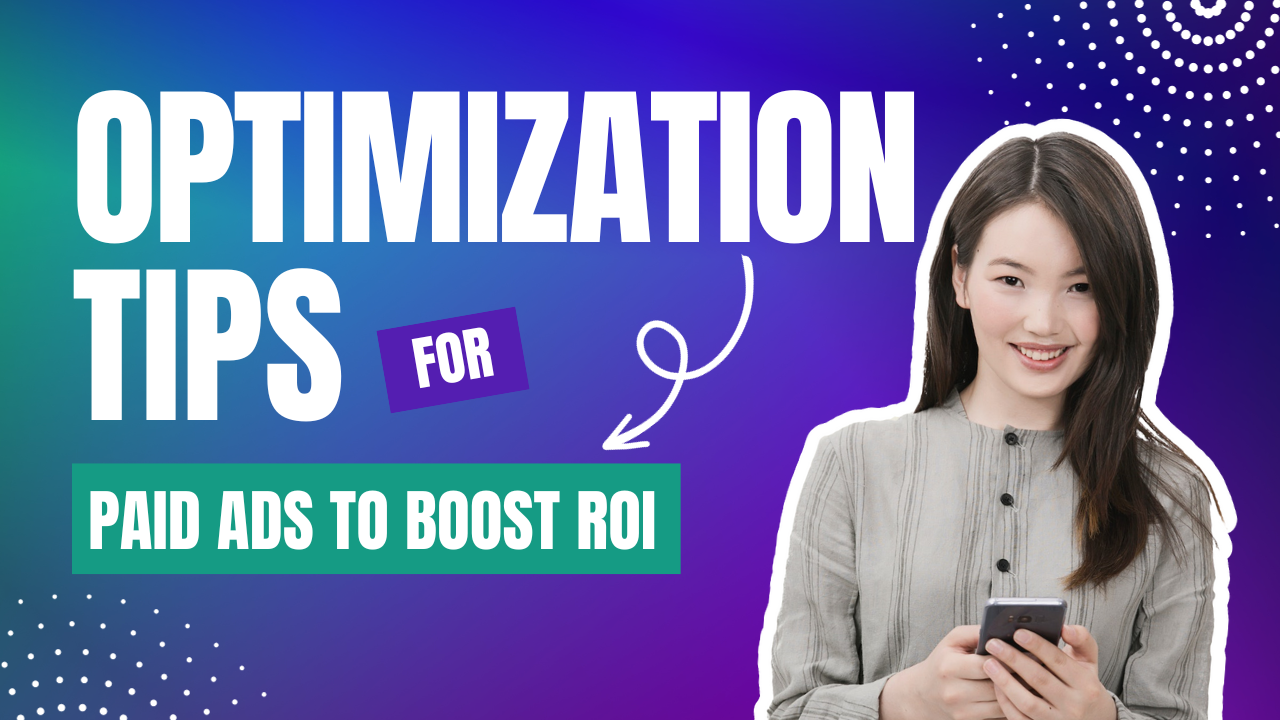- admin
- 0 Comments
- 317 Views
Introduction
If you are a small business owner looking to expand your online presence and drive targeted traffic to your website, mastering the art of Google Ads optimization is essential. In today’s digital landscape, Google Ads offers small businesses a powerful platform to reach potential customers and boost their online visibility. By understanding the benefits of Google Ads optimization, you can fine-tune your advertising strategy to maximise your return on investment (ROI) and propel your small business to new heights.
Setting the Foundation for Success
Before diving into the world of Google Ads optimization, it’s crucial to establish a strong foundation for success. This involves defining your advertising goals, conducting thorough market research, and identifying your target audience.
Defining Your Advertising Goals
Having clear and concise advertising goals is the first step towards running a successful Google Ads campaign. Whether you aim to increase website traffic, generate leads, or drive sales, clearly defining your objectives allows you to align your optimization efforts and measure your campaign’s success.
Conducting Thorough Market Research
Market research is a vital component of any successful advertising campaign. By conducting thorough research, you can gain valuable insights into your industry, competitors, and target audience. This information will help you make informed decisions when refining your Google Ads strategy.
Identifying Your Target Audience
Understanding your target audience is crucial for optimising your Google Ads campaigns effectively. By identifying your ideal customers, you can create more targeted and relevant ads that resonate with your audience’s needs and desires. This will result in higher click-through rates (CTRs) and better conversion rates.
Crafting an Effective Google Ads Strategy
Now that you have a solid foundation, it’s time to craft an effective Google Ads strategy. This involves thorough keyword research and selection, compelling ad copywriting, harnessing the power of ad extensions, and optimising landing pages for maximum conversions.
A. Keyword Research and Selection
Keywords are the foundation of any effective Google Ads campaign. Understanding the importance of relevant keywords is vital for targeting the right audience and improving your ad’s visibility.
You can use a variety of tools and approaches to undertake efficient keyword research. Google’s Keyword Planner, for example, provides insights into search volume, competition, and suggested bid amounts for specific keywords. Additionally, exploring long-tail keywords, which are more specific and less competitive, can help you reach a more targeted audience.
After conducting keyword research, refining and selecting high-performing keywords is essential. Continuously monitoring and evaluating their performance allows you to optimise your campaign for better results.
B. Compelling Ad Copywriting
Writing persuasive and attention-grabbing ad copy is crucial for capturing your audience’s attention. Incorporating elements such as a strong value proposition, emotional appeals, and unique selling points can make your ads stand out from the competition.
Crafting attention-grabbing headlines is equally important. The headline is often the first thing users see, so it should be compelling and relevant to the user’s search intent. It’s important to experiment with different headline variations to find what works best for your audience.
Incorporating persuasive call-to-actions (CTAs) can also significantly impact your ad’s performance. Clear and compelling CTAs prompt users to take the desired action, whether it’s making a purchase, signing up for a newsletter, or requesting more information.
C. Ad Extensions for Enhanced Visibility
Ad extensions play a crucial role in enhancing the visibility and effectiveness of your Google Ads. They provide additional information and options for users, making your ads more comprehensive and engaging.
Using site link extensions allows you to showcase additional links to specific pages on your website, directing users to relevant information or offers. Maximise the use of callout extensions to highlight unique selling points and benefits. Structured snippet extensions, on the other hand, enable you to showcase specific features or categories related to your products or services.
D. Effective Landing Page Optimization
Optimising your landing pages is vital for enhancing conversions and ensuring a seamless user experience. Landing pages should be designed with ad relevance in mind, offering users a clear and direct path to take the desired action.
Incorporating strong CTAs on your landing pages can nudge visitors towards making a purchase or completing a lead form. Additionally, optimising page load speed is crucial, as slow-loading pages can lead to high bounce rates and missed opportunities.
Structuring Profitable Google Ads Campaigns
Once you have a solid strategy in place, it’s essential to structure your Google Ads campaigns for maximum profitability. This involves setting up campaign settings and structure, choosing the right bidding strategies, organising ad groups effectively, and optimising ad scheduling and location targeting.
A. Campaign Settings and Structure
Understanding different campaign types and their objectives is crucial for setting up well-structured campaigns. Whether you opt for search campaigns, display campaigns, or video campaigns, aligning your campaign settings with your objectives ensures optimal performance.
Creating a well-structured campaign hierarchy allows for easy management and optimization. By organising campaigns based on different products, services, or target locations, you can effectively monitor and adjust your ads’ performance.
B. Ad Group Organization
Ad group organisation goes hand in hand with campaign structure and plays a significant role in optimising your Google Ads campaigns. By grouping keywords based on relevance and targeting, you can create more targeted and tailored ads, resulting in improved CTRs and conversion rates.
Creating compelling ad variations for each ad group allows you to experiment and find the most effective messaging to resonate with your target audience.
C. Ad Scheduling and Location Targeting
Maximising your campaign’s results requires strategic scheduling. Understanding when and where your target audience is most active online can help you schedule your ads to reach them at the optimal times.
Geotargeting, whether for local or global reach, allows you to ensure your ads are displayed in specific locations in alignment with your business goals and target market. Fine-tuning locations based on performance metrics helps optimise your campaigns as you gather valuable insights into the most profitable areas.
D. Ad Testing and Experimentation
A/B testing is an essential technique for optimising ad performance. By running different versions of your ads and measuring their performance, you can identify what resonates best with your audience and refine your messaging accordingly.
Conducting ad experiments involves tweaking various elements, such as headlines, ad copy, visuals, and CTAs. Continuously iterating and optimising your ads based on the results allows for continuous improvement and better performance.
Harnessing Advanced Google Ads Optimization Techniques
To truly supercharge your small business with Google Ads, it’s vital to harness advanced optimization techniques. This involves leveraging remarketing and audience targeting, imple
menting conversion tracking and analytics, optimising for mobile devices, and creating visually appealing display and video ads.
A. Remarketing and Audience Targeting
Remarketing is a powerful tool that allows you to reach potential customers who have previously interacted with your website or shown interest in your products or services. By targeting these users, you remind them of your brand and increase the chances of converting them into customers.
Understanding audience targeting options, such as demographic targeting, affinity targeting, and in-market targeting, enables you to customise your ads to resonate with specific segments of your audience. Personalising ads for different audience segments based on their interests and preferences can significantly increase engagement and conversions.
B. Conversion Tracking and Analytics
Setting up conversion tracking is crucial for accurate insights into your campaign’s performance. By tracking specific actions that indicate a user’s conversion, such as a purchase or a form submission, you can measure the effectiveness of your ads and optimise accordingly.
Utilising Google Analytics provides additional data-driven decision-making capabilities. Analysing key metrics such as bounce rates, average session duration, and conversion paths allows you to identify areas of improvement and optimise your ads for better performance.
C. Mobile Optimization for Enhanced Reach
With the increasing dominance of mobile devices, optimising your Google Ads campaigns for mobile is essential. Implementing mobile-friendly ad creation practices ensures that your ads are optimised to deliver a seamless and engaging experience to mobile users.
Best practices for mobile-friendly ad creation include utilising responsive ad formats, ensuring fast page load speeds, and optimising ad copy for shorter attention spans. Leveraging mobile-specific ad extensions and targeting options such as click-to-call and proximity targeting allows you to capitalise on mobile users’ behaviour and preferences.
D. Display and Video Ads Optimization
Display and video ads offer unique opportunities to engage your audience visually. To optimise these types of campaigns, it’s crucial to strategize effectively and maximise targeting options.
Designing visually appealing and engaging ad creatives is key to capturing users’ attention. Utilise professional graphics, compelling visuals, and concise messaging to convey your brand’s offerings effectively.
Leveraging precise targeting options, such as contextual targeting and topic targeting, ensures that your display and video ads are shown to the most relevant audience. Continuously monitoring and optimising your campaigns based on performance metrics will enable you to maximise reach and engagement.
Monitoring, Measuring, and Optimising Success
Monitoring the performance of your Google Ads campaigns is crucial for ongoing success. By tracking key performance indicators (KPIs), using Google Ads dashboard and reporting tools, and continuously optimising based on data-driven insights, you can achieve maximum ROI and drive your small business
towards success.
A. Monitoring Performance Metrics
Monitoring performance metrics allows you to measure the effectiveness of your Google Ads campaigns. Key performance indicators such as click-through rates (CTR), conversion rates (CVR), cost per conversion (CPA), and return on investment (ROI) provide invaluable insights into your campaign’s performance.
Utilising Google Ads’ built-in dashboard and reporting tools simplifies the process of tracking and analysing your campaign’s performance. These tools offer in-depth insights, allowing you to identify areas of improvement and make data-driven decisions.
B. Continuous Optimization Techniques
Utilising data to make informed optimization decisions is crucial for ongoing success. By analysing performance metrics, adjusting bids and budgets, and implementing ad schedule optimizations based on performance, you can continuously improve the effectiveness of your campaigns.
Monitoring and optimising bid strategies allows you to allocate your budget effectively, ensuring maximum ROI. Adjusting bids based on keywords’ performance and seasonal trends can significantly impact your campaign’s success.
Implementing ad schedule optimizations based on performance metrics enables you to focus your budget on peak times when your audience is most likely to engage with your ads. This allows for more efficient spending and better results.
C. Competitive Analysis and Benchmarking
Conducting competitor analysis provides valuable insights into your industry and allows for strategic advantages. By understanding your competitors’ strategies, messaging, and targeting techniques, you can optimise your own Google Ads campaigns to stand out and attract more customers.
Benchmarking your performance against industry standards helps you gauge your campaign’s success and identify areas for improvement. Analysing your competitors’ performance metrics and strategies provides valuable insights that you can implement to optimise your own campaigns for better results.
Conclusion
Mastering the art of Google Ads optimization is vital for small businesses looking to propel themselves to new heights. By setting clear goals, conducting thorough market research, and crafting an effective Google Ads strategy, you can elevate your online presence and reach your target audience more effectively.
Structuring profitable Google Ads campaigns, harnessing advanced optimization techniques, and continuously monitoring and optimising your ads based on performance
metrics can significantly boost your small business’s performance and drive sustainable growth.
By following these best practices, small businesses can leverage the power of Google Ads to supercharge their online presence, expand their customer base, and achieve long-term success.
Frequently Asked Questions (FAQs)
1. How long does it take to see results with Google Ads optimization?
The timeline for seeing results with Google Ads optimization can vary depending on various factors, including your industry, competition level, budget, and targeting methods. However, with continuous monitoring and optimization, you can start seeing improvements in your performance within a few weeks.
2. Should I focus on organic search or Google Ads for my small business?
Both organic search and Google Ads play important roles in a comprehensive digital marketing strategy. While organic search can provide long-term benefits, Google Ads allows for immediate visibility and targeted reach. Combining both can help maximise your online presence and drive results.
3. How can I ensure my ads are cost-effective without compromising performance?
To ensure cost-effective ads, monitor your campaigns regularly, analyse performance metrics, and make data-driven optimizations. Continuously refine your targeting options, experiment with ad variations, and adjust your bids based on performance to achieve a balance between cost-effectiveness and performance.
4. Is it possible to run Google Ads campaigns on a limited budget?
Yes, it is possible to run Google Ads campaigns on a limited budget. By strategically selecting keywords, leveraging long-tail keywords, optimising ad relevance, and monitoring your budget closely, you can maximise the impact of your budget and achieve results even with a limited investment.
5. What are the common mistakes to avoid when optimising Google Ads?
Some common mistakes to avoid when optimising Google Ads include lack of proper keyword research, irrelevant ad copy, poor landing page optimization, improper campaign structuring, insufficient monitoring of performance metrics, and not leveraging advanced optimization techniques. By avoiding these mistakes, you can ensure a more successful Google Ads campaign.
6. Can I rely solely on Google Ads optimization for long-term success?
While Google Ads optimization can be a powerful tool for driving immediate results and boosting your small business’s online performance, it’s important to diversify your marketing efforts for long-term success. Combining Google Ads with other digital marketing tactics, including SEO, content marketing, and social media, can help create a holistic marketing strategy and ensure sustained growth.





